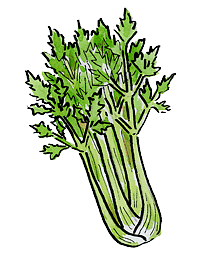Celery

Celery is usually considered a crop for experienced gardeners, not beginners. In fact, it is quite easy to grow, but has some very specific needs. Give it plenty of water and a good rich soil, and you can have a supply of celery from midsummer into late fall. If you allow the soil to dry out, you will get celery, but it will be tough, bitter and chewy more fit for cows than people. Grow it well and you'll be surprised to discover that homegrown celery has real flavor, not just crunch.
Celery is a slow grower. Start the seeds indoors 10-12 weeks before the last frost date. To get good germination, don't cover the seeds with soil they need light in order to germinate. Simply press the seeds into potting soil that's formulated for seed-starting and cover the trays or pots with plastic covers to hold the moisture. Germination should take place in about a week.
Plant your celery outdoors when the soil temperature reaches 50 degrees F. or more, and when the nights don't dip down below 40 degrees F. It takes three to four and a half months for celery to mature, depending on the variety. But the good news is you can start picking the stalks whenever you want. Young celery is as good as — or better — than the mature product.
Celery is not very frost-hardy, so select a variety that is suited to your climate and get an early start. It grows best in full sun, but part shade is acceptable. Give your plants a drink of manure tea, fish emulsion or liquid fertilizer once a month to boost their size.
Store-bought celery is almost always taller and more robust than the celery you grow in your own garden. Its stalks are also very pale (rather than green) because the stems of commercially-produced celery are protected from sunlight. For flavoring soups, stews and other dishes, homegrown celery has far more flavor. Both the stalks and the leaves can be dried or frozen for winter use. To freeze celery, just cut the stalks into half-inch pieces and store in freezer-grade bags.
To discourage pests celery is appealing to flea beetles, slugs, snails, earwigs and more cover the plants with garden fabric (row covers) during the first four to six weeks of the growing season.
Last updated: 09/26/2022
Print this Article:
Get the Dirt
Stay up to date on new articles and advice. Please fill out the information below.
